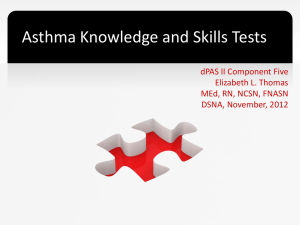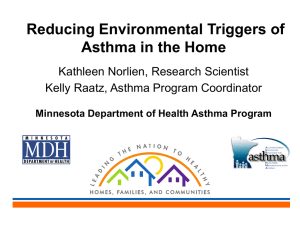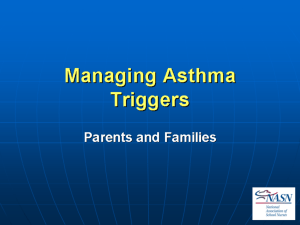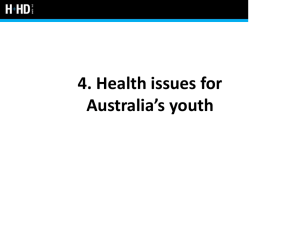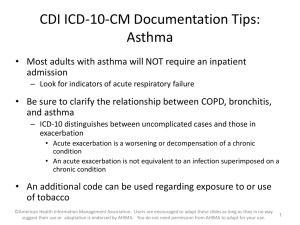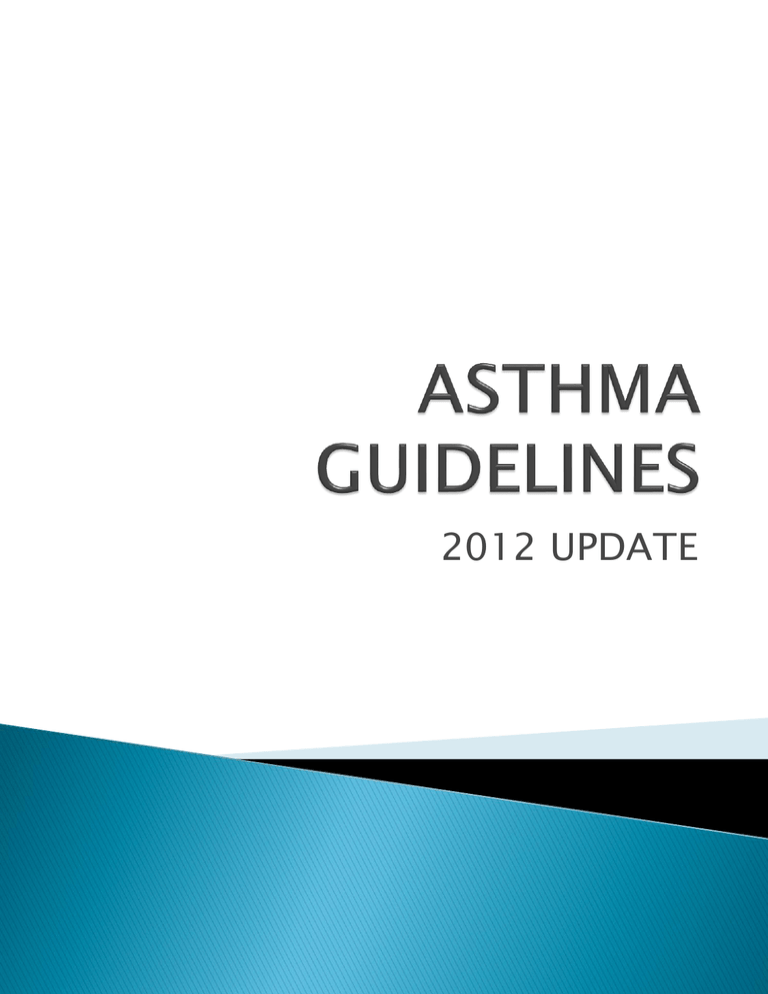
2012 UPDATE
What guidelines do we have
available to follow for asthma
1)
2)
3)
4)
Asthma GP monitoring
Guideline
Asthma Diagnosis Guideline
Acute asthma management
guideline
Asthma Stepwise management
The 2012 guidelines for Asthma
have been written to improve the
way we care for our asthma
patients.
The first part of the guidelines
sets out the requirements of a
good annual review.
NHS Calderdale, NHS Kirklees and NHS Wakefield District
Primary Care asthma monitoring /annual review for adults
History
Number of exacerbations since
last seen in clinic
Emergency Department
attendance since last seen in
clinic
Emergency asthma admission
since last seen in clinic
W ork days lost since last seen in
clinic
Referral to stop smoking service
Atopy – triggers identified
Exercise symptoms
Is there a record of reversibility?
Is there any suggestion of
occupational asthma?
Flu vaccination recorded in last 12
months, if appropriate
Nebulised bronchodilators
required since last seen in clinic
Smoking status recorded
Peak flow meter at home – ensure
technique satisfactory
Last oral steroid use
Stop smoking advice given
Assessment of Asthma Control
Royal College of Physicians 3 Questions- ( minimum QOF requirement)
There are a number of validated tools that can
be used to assess asthma control.
1
Have you had difficulty sleeping because of your asthma symptoms
(including cough)?
The asthma control test can be found at
http://www.asthmacontroltest.com and is an
excellent tool for use with adult patients.
2
Have you had your usual asthma symptoms during the day (cough,
wheeze, chest tightness)?
3
Has your asthma interfered with your usual activities (work, sex,
housework, exercise)?
Assessment/examination
Height, Weight, Body Mass Index, consider need for blood tests e.g.. IgE RAST if appropriate and will change management of co ndition,
Spirometry Record at each review record FEV1 and FVC as % predicted and FEV1/FVC ratio
If spirometry is not available record Peak Expiratory Flow PEF where possible using patients own peak flow meter to record
Medication review
Discuss and record current medication
Assess inhaler technique at every review:
Is device appropriate?
Is there a need for spacer / spacer replacement (how
long in use)?
Assess *SABA use / overuse (record reliever – free
days and number of puffs used a day)
Assess concordance and understanding Drug side-effects (current) and potential risks
(eg. Steroid-induced osteoporosis)
Step up/down treatment as needed in
Issue steroid safety cards for patients on step
response to assessment.
4 & 5 of Stepwise Management of Asthma
If control is achieved and maintained, after
12 weeks inhaled cortico steroid therapy
Beclometasone or Budesonide 1000mcg
should be reduced (dose decreased by 25twice daily
50%) to the lowest step that maintains
* via spacer device or Fluticasone 500mcg
control
twice daily via spacer device
Assess and record us of OTC */herbal
medications
Consider referral to Community Pharmacist for further support with medication either through a New Medicines Service assessme nt or a
Target Medicines Use Review
Asthma Care Plan
Assess patient’s understanding of how to recognize worsening
asthma (symptoms and *PEF) and what action to take
Assess understanding of action to take in an emergency
Assess and address patients needs for education
Agree interval for asthma follow-up
Written self management/action plan given or updated
Consider referral to Expert Patients Programme
OTC – Over the Counter, * PEF- Peak Expiratory Flow , * SABA – Short-acting beta2-agonist
Group responsible for development: NHS Kirklees
in collaboration with NHS Wakefield District, Mid Yorkshire
NHS Hospitals Trust and Calderdale and Huddersfield Hospital
Foundation Trust (Kirklees Sector).
Enquiries to:
Routine review in primary care
The Sign/BTS Asthma Guidelines 2009 state there is strong evidence that proactive clinical review of
people with asthma improves clinical outcomes, with those reviews that include discussion and use of a
written self management plan being of greatest benefit.
Proactive reviews are associated with reduced exacerbation and days lost from normal activity, as
opposed to unstructured or opportunistic review. Outcomes are similar whether reviews are conducted
by a Practice Nurse or GP with the best outcomes achieved with those clinicians with asthma
management training. Identification of patients at high risk is recommended. Telephone review has
been shown to be a suitable option for those patients who fail to attend for routine reviews.
Routine management of Asthma
Offer at least annual review to all those on the asthma register
Time taken: approximately 20- 30 minutes
Conducted by healthcare professional with appropriate education
Aim: To identify if asthma is CONTROLLED or UNCONTROLLED
and take action.
Prioritise those at greatest risk of attack
• Identification via regular computer searches and reviews of medical
records
• Placement on an ‘At risk’ register for Asthma
• System devised to ‘flag up’ risk and prioritise attendance
Prioritisation of care
• Proactive recruitment to attend for asthma assessment
• Telephoning resistant ‘DNA’ (Did Not Attend) patients to assess control
and encourage attendance
• Priority / same-day appointments for those with deteriorating symptoms
who are ‘At risk’
• Consider telephone assessments
• Liaison with community pharmacists, schools, school nurses and
community colleagues e.g. community nurses
SIGN Definition of Factors
Contributing to ‘AT RISK’
• Previous near-fatal asthma
• Previous admission for asthma in the
past year (including Accident &
Emergency)
• Requiring three or more classes of
medication
• Heavy use of short acting B2 agonist
•‘ Brittle asthma'
Clinical audit and evaluation
Named healthcare professionals with appropriate qualifications
Ongoing training and educational support
Primary care asthma Review
• Previous near-fatal asthma
*How to identify of those at greatest risk – computer searches
• Hospital attendance with
•Heavy use of short-acting B2
asthma
agonist (> 3 canisters in 6 months)
attack in past 2 months
(including
•DNA asthma clinic or excepted
Emergency Department
from QOF
attendances)
• Presentation with asthma attack
in
primary care in past 2 months
•Repeated days off school or work
with
Asthma
• Two or more courses of oral
steroids and/or antibiotics in
past 6 months
•.Brittle asthma’
The next guideline looks at
diagnosis of asthma patients
We are going to look at this new
guideline with particular attention
to reversibility
Included on this guideline is the
variability required and how to
calculate that variability
Quite often a nurse is presented
with a patient who has been
reversed by a GP and commenced
medication such as Ventolin.
Management of acute asthma in
adults requires varying levels of
treatment the next guideline sets
out
the
most
appropriate
treatment
for
level
of
exacerbation.
Spacer, Nebuliser, Oxygen?
SpO2 level?
How much prednisolone?
Many asthma deaths are preventable.
Factors leading to poor outcome include:
•Failure by clinical staff to objectively assess
severity
•Patients or relatives failing to appreciate severity
•Under-use of corticosteroids
1.
2.
3.
4.
Assess (Determine severity) : Record Peak expiratory flow rate (PEFR), heart rate,
respiratory rate, oxygen saturations (SpO2) and complete a clinical examination.
Treat
(According to severity)
Reassess (Response to therapy)
Educate & Follow-up
MILD
MODERATE
ACUTE SEVERE
LIFE THREATENING
PEF >75% best or predicted
PEF >50-75% best or predicted
PEF 33-50% best or predicted
PEF <33% best or predicted
• SpO2 ≥ 92%
• Speech normal
• Respiratory rate <25/min
• Pulse <110bpm
• SpO2 ≥ 92%
• Speech normal
• Respiratory rate <25/min
• Pulse <110bpm
• SpO2 ≥ 92%
• Can’t complete sentences
• Respiratory rate ≥25/min
• Pulse ≥110bpm
999 – Admit IMMEDIATELY
Treat at home / in surgery and assess response
1. β2 bronchodilator: eg
salbutamol
Via spacer device
(2 puffs initially, and 2 puffs
every 2 minutes according
to response up to
maximum of 10puffs)
1. β2 bronchodilator eg
salbutamol
Via spacer device
(4 puffs initially, and 2 puffs
every 2 minutes according to
response up to maximum of
10puffs)
• SpO2 < 92%
• Silent chest, cyanosis
• Poor respiratory effort
• Exhaustion
• Bradycardia
1.
Oxygen (Target SpO2 94-98%)
2. Salbutamol 5mg via a nebuliser preferably oxygen
driven.
If no nebuliser available give via spacer device (4 puffs
initially, and 2 puffs every 2 minutes according to
response up to maximum of 10puffs).
2. Prednisolone 40mg (7days)
3. Prednisolone 40mg
RE-ASSESS (after
30minutes)
Stable or improved and
PEF >/=75% then allow
home
PEF <75% or clinical
deterioration then manage
according to severity
RE-ASSESS (after 30minutes)
Clinical improvement and
PEF >/= 60% allow home
Admit If:
•PEFR <60%
•No clinical improvement
•Requires second nebuliser
•Concern over social
circumstances
•Patient unable to monitor /
assess own condition
• Previous near fatal attack
Admitting to hospital
Admit if any:
Life threatening feature
Features of acute severe asthma after initial treatment
Previous near fatal asthma attack
Lower threshold for admission if:
Afternoon or evening attack
Recent nocturnal symptoms or hospital admission
Previous severe attacks
Patient unable to assess own condition or concern over social
circumstances
On discharge - Educate & Follow up
Prior to discharge (including following an Emergency Department attendance) ensure:
1 Patient is taking a regular inhaled corticosteroid
2 Inhaler technique is checked and is satisfactory
3 Medicines are explained and understood by the patient and/or carer
4 A written Self Management Plan is provided
5 Treatment is in accordance with BTS and Local guidelines and appropriate to severity of condition
6 Smoking cessation is discussed and recorded if appropriate
7 An Asthma UK ‘After your asthma attack’ leaflet is provided
8 Discuss and address potentially preventable contributors to recent exacerbation
All patients should be reviewed by GP or practice nurse within 48hrs of acute treatment , or discharge from hospital including
discharge from the Emergency Department
The
stepwise
management
reflects the guidance given on
management of asthma as
outlined by the British Thoracic
Society as shown in the BNF
This year the layout has been
changed to a more user friendly
step up step down chart
NHS Kirklees, NHS Calderdale and NHS Wakefield District
Stepwise management of asthma for adults
‘An inhaler is only as good as the technique and concordance of the patient
using it’
Good
Control
Goals of asthma therapy:
• Maximise asthma control
• Minimise number of asthma
exacerbations
• Minimise treatment side
effects
High dose ICS (1600mcg/day
beclemetasone equivalent or
Flixotide 1000mcg/day) is
associated with a greater risk of
systemic side effects including
adrenal suppression, decrease
in bone mineral density,
cataracts and glaucoma,
diabetes mellitus and adverse
psychological and behavioural
effects
STEP 4:
STEP 3:
Long acting B2 agonist (LABA)
Formoterol 12mcg twice daily or
Salmeterol 50mcg twice daily – 4
week trial initially
Poor
Good
Poor
Beclometasone
or Budesonide
Control
Control
control trial
400mcg twice daily* 3 month
If already on this dose and sub optimal
control of symptoms, proceed to next
step
Oral
PoorLeukotriene Receptor
Good
Control Antagonist: Poor
Control
control
Poor
control
Inhaled corticosteroid (ICS)
therapy risks:
Good
Control
Poor
control
Sub optimal control: any of
the below criteria
• Using reliever more than 3
times weekly
• Symptomatic more than 3
times weekly
• Waking one night a week
• Two or more courses of
rescue oral steroids in past 6
months
Issue Steroid
safety cards for
step 4 & 5
3 month trial
Sequential trial (3 months each) of:
Poor
Oral
MR Theophylline
e.g.
Poor
Good
Control
Control
Uniphyllin, titrate dose
to the
control
therapeutic range
Slow-release B2 agonist tablets
Poor
control
Good
Control
Good
Control
STEP 1:
Occasional
relief of
symptoms As
required
inhaled shortacting B2
agonist (All
patients must
have)
STEP 2:
Inhaled
corticosteroid
(ICS)
Beclometasone or
Budesonide
200mcg* twice
daily
(Qvar
100mcg**twice
daily)
No clinical trials indicating which of
these is the best option. BTS/SIGN
asthma guidelines (2009) also support
Symbicort SMART regimen in selected
patients
High dose
inhaled
corticosteroid
Beclometasone
or Budesonide
1000mcg twice
daily
* via spacer
device
or Fluticasone
500mcg twice
daily via spacer
device
STEP 5:
Use daily
steroid tablets
in the lowest
dose providing
adequate
control
Maintain high
dose ICS at
2000mcg/day.*
Consider other
treatments (as
mentioned above)
– 6 week trial
period, stop if no
improvement in
symptoms. Refer
patient for
specialist care
Poor
Control
Poor
Control
Reducing treatment:
Step down should be considered
• After 12 weeks if control is achieved (and after
every subsequent 12 week period).
• If control is maintained, therapy should be
reduced (dose decreased by 25-50% each
time) to the lowest step that maintains control
• When on combination ICS & LABA, the
preferred option is to reduce does of ICS by
50% while continuing LABA. If control is
maintained further reductions in ICS should be
made until ona low dose, when the LABA may
be stopped
• After stepping down review in 12 weeks and
step up again if symptomatic
Poor
Control
Step 3 consider referral to Respiratory Specialist: IF
Doubt about diagnosis; Asthma disrupts lifestyle ;
Possible food allergy; Consideration of nebulised
therapy; Consideration of maintenance
prednisolone; Past asthma admission; Second
opinion; Anaphylaxis; Pregnant women with
worsening asthma; Asthma threatening
employment; Suspected occupational asthma;
Poor control
including
exacerbation of
asthma requiring
oral
corticosteroids in
the last 2 years
* For Budesonide and certain Beclometasone inhalers (see overleaf) ** Qvar, Fostair, Fluticasone
need lower dose for equivalence (see overleaf)
Group responsible:
Enquiries to:
Published:
Review due:
(unless clinical evidence base changes)
Notes
• Select the least costly
product that is
suitable for an individual,
within its
marketing authorisation
• Patient Education
- Each patient
should have a clear
understanding of
how to recognise
and deal with
deterioration
- An individual
self-management
plan is essential
- Patients should
have a basic
understanding as
to how their
medication works
• Rescue courses of
steroids may be
required at any stage to
gain control and
stabilise the condition.
Prednisolone
40mg once daily for at
least 5 days and
until recovery of PEFR and
symptoms
• A rescue course of
steroids may indicate
the need to increase
regular treatment to
the next step
• LABA should not be used
without ICS
Combination inhalers:
• Should NOT be used
before step 3
of asthma therapy
• May improve
compliance over the
combined use of the
individual
components as
separate inhalers
Dose of inhaled corticosteroids (ICS):
Table below adapted from BTS/SIGN asthma guidelines (updated
January 2012)
shows equivalent doses of ICS:
Steroid, name, inhaler device and trade
name
Equivalent dose
Beclometasone
200mcg
* Clenil Modulite pressurised aerosol inhaler
(PAI)
200mcg
Dry Powder Inhaler
e.g. Easyhaler, Pulvinal, Asmabec
Clickhaler, Cyclocaps
200mcg
* Qvar (PAI, Autohaler or Easi-Breathe)
100mcg
Fostair$
100mcg
Budesonide
200mcg
Dry Powder Inhaler
e.g. Easyhaler, Budelin Novoliser, Pulmicort
Turbohaler & Symbicort
200mcg
Fluticasone
100mcg
Pressurised aerosol inhaler
e.g. Flixotide Evohaler & Seretide$ Evohaler
100mcg
Dry Powder Inhaler
e.g. Flixotide Accuhaler, Flixotide Diskhaler
& Seretide$ Accuhaler
100mcg
Mometasone
100mcg
• Must be prescribed by brand name
$ Combinations with long acting B2 agonists (LABA): Take care prescribing
these as the relative amounts of steroids and LABA differ100
depending
on the
Ciclesonide
– 150mcg
particular product chosen.
Information on inhaler technique is available at:
http://www.medicines.org.uk/guides/pages/how-to-use-your-inhaler-videos
http://www.asthma.org.uk/how-we-help/teachers-and-healthcareprofessionals/health-professionals/interactive-inhaler-demo/
For telephone review or persistent DNA’s Consider referral to a community
Pharmacist for inhaler technique review as part of a targeted Medicines Use
Review or New Medicine Service review.
Smoking is a major trigger factor for asthma and a significant cause of poor
control, reducing exposure to cigarette smoke is essential Stop Smoking advice
and avoidance is vital.
Manage gastro-oesophageal reflux & rhinitis as clinically appropriate, there is
however, a lack of evidence that this will improve asthma control
Despite best efforts or not lots of
asthma patients attend casualty
costing over £50 simply for walking
through the A+E doors.
Follow up all A+E attendances
Have the respiratory/asthma A+E
reports passed over and get them in
to see you for a Self Management
Plan and Emergency Rescue Pack
issuing (if needed) or to change their
inhalers as per the stepwise
guidelines


